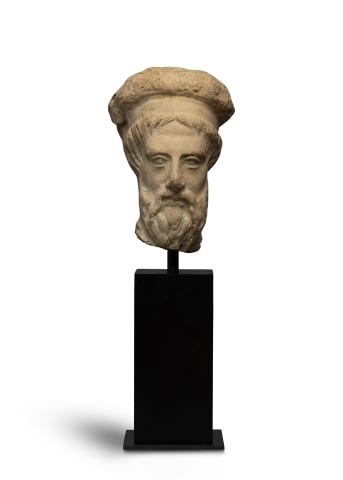Greek head of a man with headdress, South Italy, Tarentum, c.400 BC
Terracotta
Height: 9.7cm
10600 IVP
£ 5,800
Head from a statuette of a banqueter, probably forming part of a larger group and quite possibly identified as Dionysus, the god of wine. He is wearing a tall headdress...
Head from a statuette of a banqueter, probably forming part of a larger group and quite possibly identified as Dionysus, the god of wine. He is wearing a tall headdress which keeps his centrally-parted, well-groomed hair from his face. He has delicate facial features, a long narrow face, and a neatly trimmed, wavy beard and moustache. A single wrinkle on his forehead. Intact.
The most popular of figures found in Tarentum are of Dionysus reclining on a couch, sometimes with a woman at his feet who during the 4th century BC is usually holding a child. It is thought that the female figure is Persephone, and the child Iacchus. Complete examples of this group are very rare, however their production lasted the whole way through Tarentum’s period of sculptural posterity, the rendering of the figures and their heads constantly keeping vogue with the times. The distinguishing feature which allows one to identify the male head as coming from one such group is the central rosette attached to a plume or lotus-flower on the headdress, which later evolved to an additional rosette either side of the head. He was shown both bearded and clean-shaven, but always with relative youth, a strong torso and drapery about his waist. The figures were usually made without a reverse and were instead supported by struts, though the heads were finished roughly, in the round.
The most popular of figures found in Tarentum are of Dionysus reclining on a couch, sometimes with a woman at his feet who during the 4th century BC is usually holding a child. It is thought that the female figure is Persephone, and the child Iacchus. Complete examples of this group are very rare, however their production lasted the whole way through Tarentum’s period of sculptural posterity, the rendering of the figures and their heads constantly keeping vogue with the times. The distinguishing feature which allows one to identify the male head as coming from one such group is the central rosette attached to a plume or lotus-flower on the headdress, which later evolved to an additional rosette either side of the head. He was shown both bearded and clean-shaven, but always with relative youth, a strong torso and drapery about his waist. The figures were usually made without a reverse and were instead supported by struts, though the heads were finished roughly, in the round.
Provenance
Tom Virzi (1881-1974), New York, USA; acquired first half of the 20th centuryGalleria Serodine, Ascona, Switzerland
Private collection, Switzerland; collection no.168, acquired from the above, 1994
